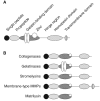Matrix metalloproteinases and myocardial infarction
- PMID: 17622396
- PMCID: PMC2651917
- DOI: 10.1016/s0828-282x(07)70818-8
Matrix metalloproteinases and myocardial infarction
Abstract
Acute myocardial infarction (AMI) is currently one of the most important health problems in many countries around the world. Following AMI, many cytokines and proteolytic enzymes are released. Among these, matrix metalloproteinases (MMPs) are important proteolytic enzymes that lead to degradation of the extracellular matrix and to changes in cardiomyocytes in both infarcted and noninfarcted myocardium. This process is known as cardiac remodelling. It has been demonstrated that more than one type of MMP is present in the circulation after cardiomyocyte injury. A number of studies have demonstrated the correlations between these MMP levels and the severity of a coronary lesion, the progression of left ventricular dimension and the survival rate following AMI in both animal and human studies. MMPs have also been proposed as a possible novel prognostic indicator for myocardial infarction patients. Although the use of MMP inhibitors to improve cardiac outcome in AMI patients has been investigated, discrepancies in the results from those studies indicate that further research is still needed to warrant their beneficial effects. In the present review article, the roles of MMPs as prognostic indicators, as well as the factors influencing MMP expression, are discussed. Current findings on the role of MMP inhibitors in cardiac remodelling and the prognosis after AMI in both animal models and clinical studies are also examined.
L’infarctus aigu du myocarde (IAM) est l’un des principaux problèmes de santé dans le monde, aujourd’hui. Après un IAM, il y a libération de nombreuses cytokines et enzymes protéolytiques. Les métalloprotéinases matricielles (MPM), enzymes protéolytiques importantes, entraînent la dégradation de la matrice extracellulaire et une modification des cardiomyocytes, et ce, tant dans le myocarde infarci que dans le myocarde non infarci. Le processus s’appelle « remodelage cardiaque ». Il a été démontré que plus d’un type de MPM se trouve dans la circulation après une lésion des cardiomyocytes. Des corrélations ont été établies entre le taux de MPM et la gravité des lésions coronariennes, l’évolution de la grosseur du ventricule gauche et le taux de survie après un IAM dans des études expérimentales sur animal et dans des recherches chez les humains. Des chercheurs ont aussi suggéré de faire des MPM un nouvel indicateur de pronostic chez les patients ayant subi un infarctus aigu du myocarde. Même si des études ont été menées sur l’utilisation des inhibiteurs des MPM dans le but d’améliorer l’état du cœur après un IAM, des résultats divergents indiquent la nécessité de poursuivre les recherches sur le sujet afin de confirmer leurs bienfaits. Il sera question, dans le présent exposé de synthèse, du rôle des MPM comme indicateur de pronostic et des facteurs qui influent sur l’expression des MPM. Nous examinerons également les résultats actuels sur le rôle des inhibiteurs des MPM dans le remodelage cardiaque et sur le pronostic après un IAM dans des modèles animaux et dans des études cliniques.
Figures

Similar articles
-
Matrix metalloproteinase inhibition after myocardial infarction: a new approach to prevent heart failure?Circ Res. 2001 Aug 3;89(3):201-10. doi: 10.1161/hh1501.094396. Circ Res. 2001. PMID: 11485970 Review.
-
[Comparison of doxycycline, losartan, and their combination on the expression of matrix metalloproteinase, tissue inhibitor of matrix metalloproteinase, and collagen remodeling in the noninfarcted myocardium after acute myocardial infarction in rats].Zhongguo Yi Xue Ke Xue Yuan Xue Bao. 2005 Feb;27(1):53-61. Zhongguo Yi Xue Ke Xue Yuan Xue Bao. 2005. PMID: 15782494 Chinese.
-
Enhanced cardiac production of matrix metalloproteinase-2 and -9 and its attenuation associated with pravastatin treatment in patients with acute myocardial infarction.Clin Sci (Lond). 2007 Jan;112(1):43-9. doi: 10.1042/CS20060110. Clin Sci (Lond). 2007. PMID: 16939410
-
Effects of Matrix Metalloproteinases on the Performance of Platelet Fibrin Gel Spiked With Cardiac Stem Cells in Heart Repair.Stem Cells Transl Med. 2016 Jun;5(6):793-803. doi: 10.5966/sctm.2015-0194. Epub 2016 Apr 25. Stem Cells Transl Med. 2016. PMID: 27112177 Free PMC article.
-
Matrix metalloproteinases in the progression of heart failure: potential therapeutic implications.Drugs. 2001;61(9):1239-52. doi: 10.2165/00003495-200161090-00002. Drugs. 2001. PMID: 11511020 Review.
Cited by
-
Interleukin-4 and Interleukin-17 are associated with coronary artery disease.Clin Cardiol. 2024 Feb;47(2):e24188. doi: 10.1002/clc.24188. Epub 2023 Dec 25. Clin Cardiol. 2024. PMID: 38146141 Free PMC article.
-
Loss of Bone Morphogenetic Protein-9 Reduces Survival and Increases MMP Activity After Myocardial Infarction.JACC Basic Transl Sci. 2023 Aug 16;8(10):1318-1330. doi: 10.1016/j.jacbts.2023.05.017. eCollection 2023 Oct. JACC Basic Transl Sci. 2023. PMID: 38094696 Free PMC article.
-
Recent advances in soluble decellularized extracellular matrix for heart tissue engineering and organ modeling.J Biomater Appl. 2023 Nov;38(5):577-604. doi: 10.1177/08853282231207216. J Biomater Appl. 2023. PMID: 38006224 Free PMC article. Review.
-
Engineered heart tissue maturation inhibits cardiomyocyte proliferative response to cryoinjury.J Tissue Eng. 2023 Oct 11;14:20417314231190147. doi: 10.1177/20417314231190147. eCollection 2023 Jan-Dec. J Tissue Eng. 2023. PMID: 37842206 Free PMC article.
-
Role of Matrix Metalloproteinase-2 in the Development of Atherosclerosis among Patients with Coronary Artery Disease.Mediators Inflamm. 2023 Jul 7;2023:9715114. doi: 10.1155/2023/9715114. eCollection 2023. Mediators Inflamm. 2023. PMID: 37457745 Free PMC article. Review.
References
-
- Hansson GK. Inflammation, atherosclerosis, and coronary artery disease. N Engl J Med. 2005;352:1685–95. - PubMed
-
- McKay RG, Pfeffer MA, Pasternak RC, et al. Left ventricular remodeling after myocardial infarction: A corollary to infarct expansion. Circulation. 1986;74:693–702. - PubMed
-
- White HD, Norris RM, Brown MA, Brandt PW, Whitlock RM, Wild CJ. Left ventricular end-systolic volume as the major determinant of survival after recovery from myocardial infarction. Circulation. 1987;76:44–51. - PubMed
-
- Creemers EE, Cleutjens JP, Smits JF, Daemen MJ. Matrix metalloproteinase inhibition after myocardial infarction: A new approach to prevent heart failure? Circ Res. 2001;89:201–10. - PubMed
-
- Rajavashisth TB, Xu XP, Jovinge S, et al. Membrane type 1 matrix metalloproteinase expression in human atherosclerotic plaques: Evidence for activation by proinflammatory mediators. Circulation. 1999;99:3103–9. - PubMed
Publication types
MeSH terms
Substances
LinkOut - more resources
Full Text Sources
Other Literature Sources
Medical

